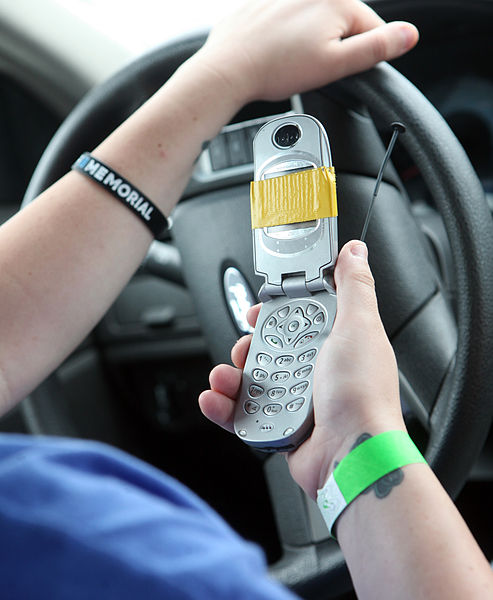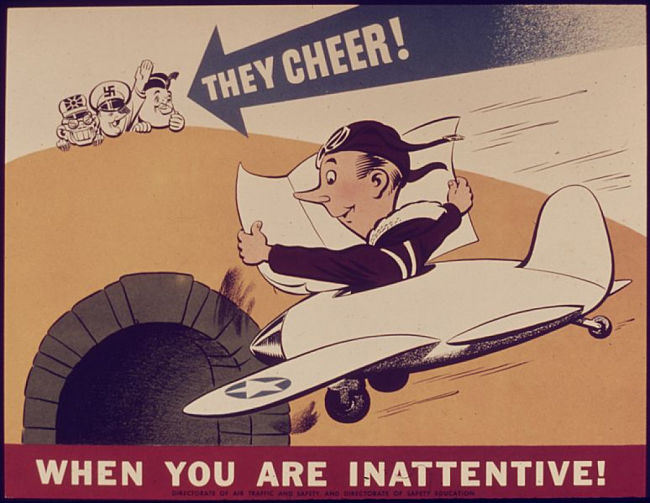Driver Distraction, Inattention and Highway Hypnosis
Recent research has shown that the average driver becomes distracted when driving about once every six minutes or ten times per hour. Crash statistics show that about 10-20% of accidents are caused by driver distraction.
The most common cause of distraction was general lack of concentration by the driver, adjusting equipment in the vehicle, external events and people, and talking to passengers.
Another study reported that drivers' use of a mobile phone up to 10 minutes prior to an accident was linked with a 400% increase in the accident risks. Drowsiness and falling asleep at the wheel are other major cause of accidents.
In one study about two-thirds of drivers interviewed reported that they had felt drowsy when driving in the last 12 months, and about half of these reported that they had fallen asleep, briefly while driving.
It is estimated that about 5% of accidents, some of which caused fatalities, were associated with falling asleep or drowsiness when driving.
A relatively new concept for distraction was highlighted by a recent train derailment in New York, which is referred to as 'highway hypnosis', 'white line fever' or 'driving without attention mode' driving.
This article explains what this is, and whether or not it is as dangerous as drowsiness or distraction when driving. Ways of reducing the risks of highway hypnosis are also highlighted.




What is Highway Hypnosis?
Highway hypnosis is probably best described as partial inattentiveness and a separation between the conscious and unconscious responses of the body and brain. One tell-tale sign is that people 'switch off' briefly can not recall the previous few seconds or minutes of their trip. People are not asleep, but they are not fully conscious or attentive either. It means that people are not fully and consciously engaged in the task of driving the vehicle.
Psychologists first identified the phenomenon in 1921. One early publication referred to “road hypnotism” associated with people traveling along straight long roads in boring surroundings to enter a “trance-like state.” In 1929, an paper was published about the same thing. It referred to a state where drivers were “Sleeping with the Eyes Open”. The paper suggested that general fatigue and the monotony of driving along straight long highways induced a trace like state that was akin to sleeping without closing the eyes situations often tended to enter a sleep-like state without closing their eyes.
On very familiar roads people may go into an auto-drive state, whilst being fully aware of the road conditions and road signs. In this state, the driver's conscious mind is apparently diverted on other things, but the unconscious mind is still processing all of the myriads of information required to drive a car safely. Somehow people are still aware of turns, red lights, and lane changes even though they have “zone out” and become less conscious and attentive.
Highway hypnosis is just one example where the unconscious and conscious minds appear to concentrate on different things. This may be related to 'day dreaming' or even 'staring into space'. Many people do it on long boring walks or even jogs as well
Often it appears that people on familiar roads in highway hypnosis can still drive well and are more or less fully responsive to events on the road. They are able to respond unconsciously to cars ahead slowing down, cars changing lanes or even to animals that may dart out onto the road. However, drivers on unfamiliar highways on long trips may be less capable of driving properly in this state. They may miss road signs and be less aware of changes in road conditions, number of lanes and merging traffic.
Cruise control and other auto drive equipment may increase the risk that highway hypnosis may lead to accidents. There are a disturbing number of cases where drivers have collided with the car in front or gone off the road at speed when there were no signs of skid marks or emergency swerves or braking. While it may be assumed that the drivers had fallen asleep, it could be that the drivers were under highway hypnosis when they crashed.
In some ways highway hypnosis may be a prelude to sleep (a 'day dream'). Drivers using auto-cruise are required to change the setting for various speed zones. If drivers are not conscious they may miss the sign posts and may fail to reduce the speed for the new zone. In this way partial inattentiveness may increase the risks of crashed when drivers are using cruise control. Distracted drivers may also fail to see the signs, especially on unfamiliar roads.
What Causes Highway Hypnosis?
Some researchers believe the lack of stimulation, fatigue, boredom, the unchanging road conditions and repetitiveness of long distance drives may trigger a brain response similar to meditation. The sub-conscious is still highly engaged, but consciousness is briefly switch-off. It is a trace like state even if it is not meditation.
Some of the causes and things associated with highway hypnosis are:
► Monotony of the driving
► The fatigue and boredom of the driver
► The ease of the driving experience - long straight highways, few bends and condition changes
► Constancy in the scenery, environment and driving environment.
► Lack of stimulation and attentiveness of the driver. Such engagement may require actions from the driver such as looking around, moving the eyes and head around and keeping the mind active while driving. This may be why highway hypnosis may be more common on familiar roads, triggered by the familiarity of the drive.
► Even if a person is staring at a fixed point way off in the distance and their eyes are not required to move much, attentive engaged drivers will still make tiny movements in response to outside stimuli such as minor changes in scenery. As people get tired they may become less engaged and more likely to 'switch off' but not sleep.
► People may not recognise that they are in a state of highway hypnosis until their environment is changed suddenly - such as a car ahead changes lanes or the car hits a bump
► Going into this autopilot-like state of highway hypnosis often happens on long, mundane freeway drives with few turns, changes in road condition or traffic signals. In a way, modern freeway designs may have made this state more common because many roads have been designed to be very boring with few bends and uniform road conditions with constant speeds.
How to Prevent and Reduce the Risk of Highway Hypnosis
The causes and triggers for onset of highway hypnosis provide simple clues about how to prevent it. This is essentially about reducing tiredness, boredom, monotony and lack of engagement and attentiveness.
Some tips to prevent and control it are:
► Taking a break every 90 minutes or so and doing some exercise or something stimulating to keep the mind engaged,
► Switch drivers and get a companion to keep you conscious and engaged on driving without being distracting (a stimulating conversation).
► Always get least six hours of sleep the night before a long trip
► Keeping the vehicle cool and open the windows. Kept the air circulating.
► Maintaining good posture
► Staying alert by deliberately doing games involving things on the road or the surroundings. This sounds silly but it can keep you engaged. Thinking of remote things may actually make things worse. The same thing applies to music - it can make you drift off.
► Be aware of the warning signs. It typically starts bout one hour after your last break on a long drive on a straight highway.
► Drivers should try to be proactive and inventive in doing things to maintain their attentiveness and engagement and note merely do things to prevent it. Checking the rear view mirror, glancing at the gas gauge, or noticing minor changes the landscape around you can help you stay alert and focused. Driver may even want to count different type of road kills - anything to keep you focused on the road.
► Recognizing the warning signs is important. This applies to drivers who regularly travel for tens of minutes without being able to recall what had happened. Drivers may also recall being jolted out of these 'trances' by a bump, a horn or something that happens on the road, when the driver has not dozed or nodded off. These are a warning signs of the need for a rest or to do something to relieve the boredom and familiarity of the drive.
► Long haul drivers are trained to constantly keep their eyes moving, changing the focus every 4-8 seconds and constantly monitoring their instrument panels.
Conclusion
Highway hypnosis is real and largely unknown risk and cause of many highway accidents. It has been made worse by the design of long boring highways and cruising control devices that remove some of the attentiveness need to drive. Drivers should be aware of the early warning signs and the ways to prevent and pro-actively do things to keep engaged on the road when driving.
There is an urgent need for more research on highway hypnosis and brain wave sensors to help detect the early onset of driver drowsiness and highway hypnosis. The development of gap sensors between cars and automatic braking are also needed to help prevent accidents cause by inattentive drivers. Similarly flashing lights triggered by unsafe speeds or even random displays of lights may be needed. Some sort of feedback device similar to the ones installed on trains many need to be devised to test that the driver is fully attentive on the road. Perhaps new highway designed should be less boring and provide more mental stimulation.